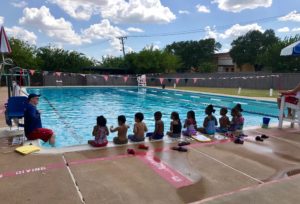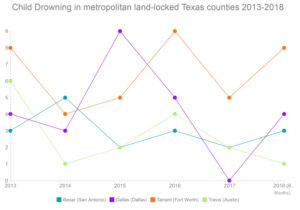Summer Safety: Accidental drowning and racial disparities
July 10, 2018 • community
School of Public Health & Texas Center for Health Disparities
Community Blog

With summer temperatures exceeding 100 degrees, Tarrant county residents often flock to pools and lakes for relief from the heat. While water can indeed bring cool relief, it can also be dangerous. In fact, as of June 27, 2018, Tarrant County is leading the state in the number of accidental child drowning victims, with a total of 7 deaths during the first six months of the year (helpandhope.org). Nationally, drowning is most common cause of injury-related deaths among youth aged 1 to 4 (Borse et al, 2008). Contrary to what you see in the movies, drowning is fast and most often silent. Tragically, many children drown in the presence of adults and other kids who did not realize what was happening.
Children are most likely to drown during summer time, and national data have highlighted significant racial disparities in these deaths. In a review of accidental drowning from 1999 to 2010, the Centers for Disease Control and Prevention reported that that African American youth aged 5-19 were 5.5 times more likely to die from drowning in swimming pools than their white peers (Gilchrist and Parker, 2014). This disparity is believed to be associated with differences in swim skills and access to swim lessons (Irwin, Irwin, Martin & Ross, 2010), which in turn is rooted in historical discrimination that restricted access to swimming pools and programs (Wiltse, 2014). While it is difficult to disentangle the influence of historical racism, socio-economic barriers, closure of public pools, cultural factors, and protective skills; it is evident that African-Americans are underrepresented in the sport of swimming and over-represented in accidental drowning. In fact, one national study showed an association between African-American participation on swim teams and unintentional drowning, where greater participation coincided with significant reductions in accidental drowning for African American males and females, but not whites (Myers, Cuesta & Lai, 2017), while controlling for other influences such as weather and access to open water.
Swimming, despite its risks, is recognized as an excellent form of physical activity. Learning to swim not only provides protection around water, it offers a healthy and low-impact way to be physically active throughout the lifespan (Chase, Sui & Blair, 2008).

The YMCA of Metropolitan Fort Worth works to increase access to swimming pools and swim lessons in underserved neighborhoods in Tarrant, Johnson, Hood, and Parker counties. The YMCA promotes youth development, healthy living and social responsibility, with drowning prevention being a key strategy to address inequities in drowning deaths. The YMCA’s Safety Around Water initiative, generously supported by donors, was launched in 2015 and served 821 people in the first two years (YMCA, 2018). The YMCA sends certified swim instructors and lifeguards to apartment complexes who offer free water safety lessons and life saving skills to youth and adults. In addition to the Safety Around Water program, the YMCA provides financial assistance for all membership and program offerings to those who qualify.

Later this summer, in partnership with the City of Fort Worth, the YMCA will open a new facility with a public pool in Renaissance Square in southeast Fort Worth. This unique partnership is designed to address historic inequities and promote water safety, and healthy living.
Contributors:
Emily Spence-Almaguer, PhD
Associate Dean for Community Engagement and Health Equity
UNT Health Science Center School of Public Health
Lindsi Smith, MPH, CPH
YMCA of Metropolitan Fort Worth
Vice President, Community Wellness and Health Innovation
Debra L. Rockmore, MPH
Association Outreach Specialist
YMCA of Metropolitan Fort Worth
McDonald Southeast YMCA
References
Borse, NN, Gilchrist, J., Dellinger, AM, Rudd, RA, Ballesteros, MF, Sleet, DA (2008).
CDC Childhood Injury Report: Patterns of Unintentional injuries among 0-19 year olds in the United States, 2000-2006. Retrieved from: https://www.cdc.gov/safechild/pdf/cdc-childhoodinjury.pdf
Chase, NL, Sui, X, & Blair, SN (2008) Comparison of health aspects of swimming with other types of physical activity and sedentary lifestyle habits. International Journal of Acquatic Research and Education, 2 (2) 151-161.
Gilchrist, J and Parker, E. (2014) Racial/Ethnic disparities in fatal unintentional drowning among persons aged </=29 years- United States, 1999-2010. Centers for Disease Control and Prevention Morbidity and Mortality Weekly Report (5/16/2014).
Texas drowning statistics from helpandhope.org. Retrieved from: http://www.helpandhope.org/Water_Safety/Child_Drownings/
Irwin, C., Irwin, R., Martin, N. & Ross, S. (2010). Constraints impacting minority swimming participation: Phase II. USA Swimming. Retrieved from: https://www.usaswimmingfoundation.org/docs/librariesprovider1/mas/2010-constraints-impacting-minority-swimming-participation-report.pdf
Myers, S.L., Cuesta, A., Yufeng, L. (2017) Competitive Swimming and Racial disparities in drowning. Rev Black Polit Econ, 44: 77-97.
Centers for Disease Control and Prevention. Drowning Prevention: Child Safety and Injury Prevention. Retrieved from: https://www.cdc.gov/safechild/drowning/index.html
Wiltse J. The black-white swimming disparity in America: A deadly legacy of swimming pool discrimination. Journal of Sports and Social Issues. 2014;38(4):366–89.
YMCA of Metropolitan Fort Worth (2018). Moving Forward: 2017 Impact Report. YMCA of Metropolitan Fort Worth.
Research reported in this publication was supported by the National Institute On Minority Health And Health Disparities of the National Institutes of Health under Award Number U54MD006882. The content is solely the responsibility of the authors and does not necessarily represent the official views of the National Institutes of Health.


Social media